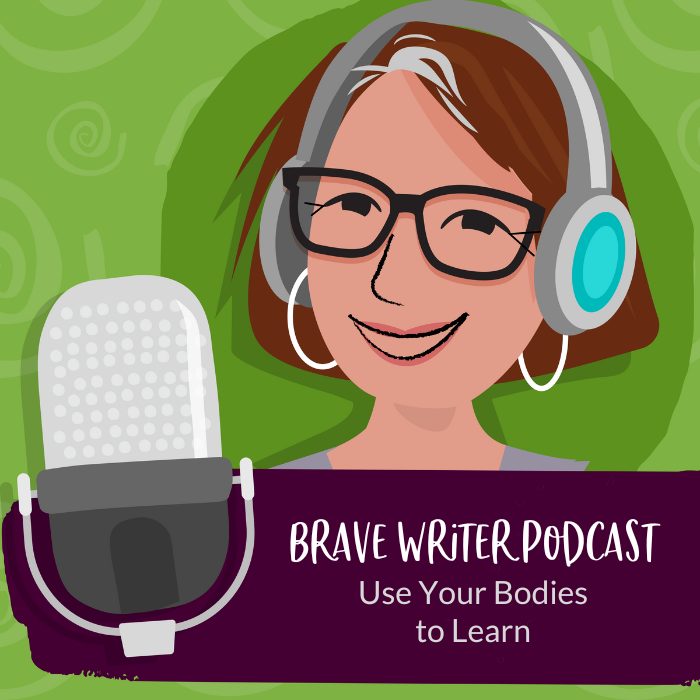Podcast: Use Your Bodies to Learn

Melissa and I just discovered an interesting coincidence about us: We both grew up as theater kids! Although we didn’t pursue theater professionally, we bonded over our kinesthetic approach to home education.
Our Brave Writer products, such as the Quill, Dart, Arrow, Boomerang, and Slingshot (affectionately abbreviated to Q-DABS), are designed to incorporate movement into learning. For example, when writing the Dart program, Melissa focused on creating activities that allow children to embody the concepts they’re learning.
As parents ourselves, we always consider how to keep kids active and engaged while teaching. Research shows that when children use their bodies to learn, they retain information better and have more fun. By creating a dynamic and enjoyable learning experience, kids start to trust that lessons can be interesting and relevant.
Come along with us as we share some of the techniques we use at Brave Writer to integrate embodied learning and make lessons more engaging and effective.
Show Notes
For learning to stick, it needs to be used. However, for abstract concepts like using the month of September, pointing out the seasons changing outside may not be enough. I found that pairing abstract concepts with kinesthetic activities helped kids retain the information better. It seemed to become a part of their muscle memory.
For struggling readers and writers, it’s important to connect the sound with the letter. By physically forming the letters with their hand and using their mouth, children can form a whole-body connection. According to the 12 Brain/Mind Learning Principles by Renate and Geoffrey Caine, all learning is physiological. Reading involves applying sounds to symbols on a page, which is a physical act. One recommended practice for copy work is for the child to vocalize the sound as they write.
The second principle of the Caines, “the brain/mind is social,” is relevant for parents who want their children to work independently while they take care of other tasks. However, learning is both social and physiological. This means that kids can benefit from using their bodies in connection with each other, such as through theater games. Therefore, it’s important for parents to provide opportunities for children to engage in social learning experiences.
Here are some of the things that we’ve done to incorporate kinesthetic learning with our kids:
- Comma-dipping: By pausing and dipping the body at commas and using other physical cues for other marks, kids can start connecting the symbols to the spoken language and their own felt experience.
- To teach prepositions, ask children to move a stuffed animal to different locations and describe its position, such as “the cat is on the chair” or “the cat is under the table.” You can also use video game characters or other familiar objects to practice prepositional phrases. By making the learning experience fun and interactive, children can develop a strong understanding of prepositions.
The kitchen table is not the only place to learn! In Brave Writer, we integrate embodied learning to make lessons more engaging and effective. We don’t just provide traditional worksheets for memorizing concepts, because research shows that when children use their bodies to learn, they retain information better and have more fun.
By creating a dynamic and enjoyable learning experience, kids start to trust that lessons can be interesting and relevant.
Resources
- Book: On Stage by Lisa Bany Winters
- Looking for a new math program? Get a free trial of CTCMath.com today to get a free trial.
- Sign up for our Text Message Pod Ring to get podcast updates and more!
- Try our Semester-Long Dart, Arrow, and Boomerang for literature and grammar activities!
- Get 10% off our Growing Brave Writers program using code GBWPOD10 at https://store.bravewriter.com/products/growing-brave-writers
- Want help getting started with Brave Writer? Head over to bravewriter.com/getting-started
- Sign up for the Brave Writer newsletter to learn about all of the special offers we’re doing in 2022 and you’ll get a free seven-day Writing Blitz guide just for signing up: https://go.bravewriter.com/writing-blitz
Connect with Julie
- Instagram: instagram.com/juliebravewriter
- Twitter: twitter.com/bravewriter
- Facebook: facebook.com/bravewriter


















